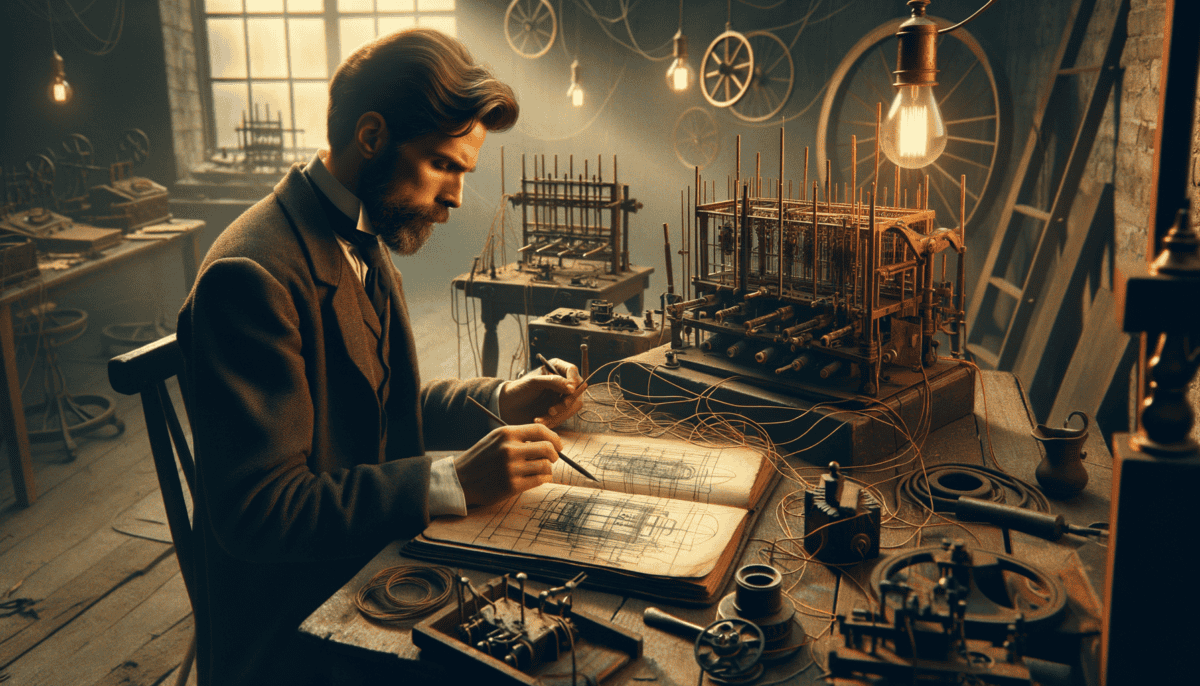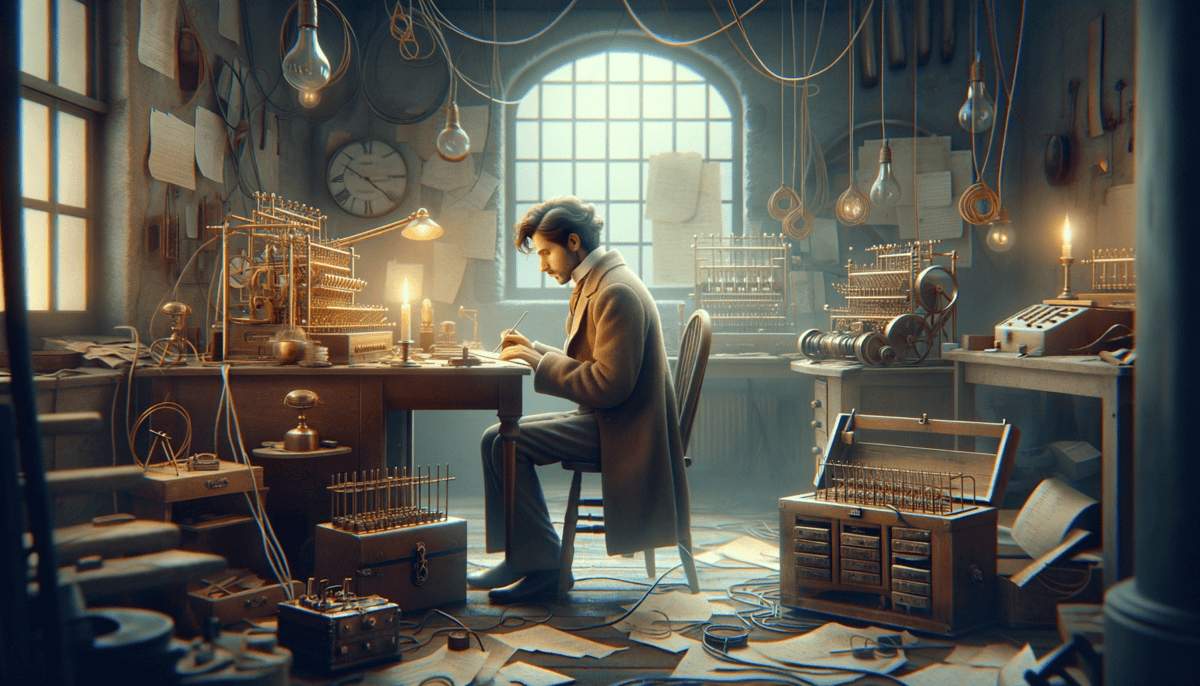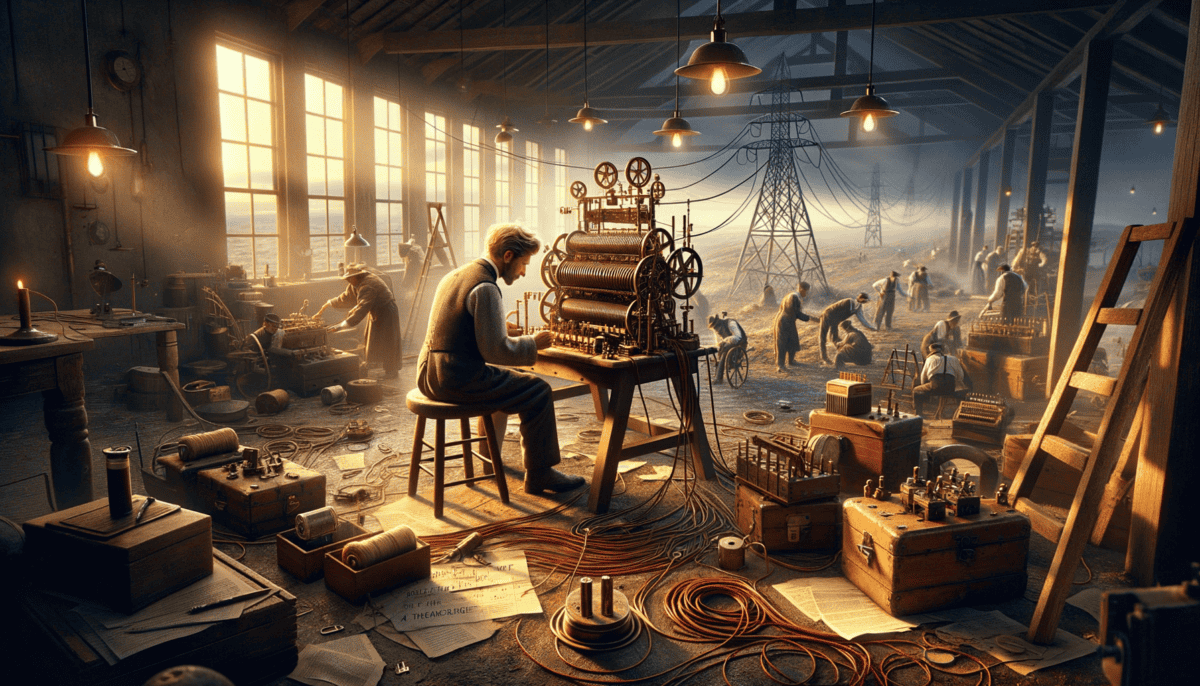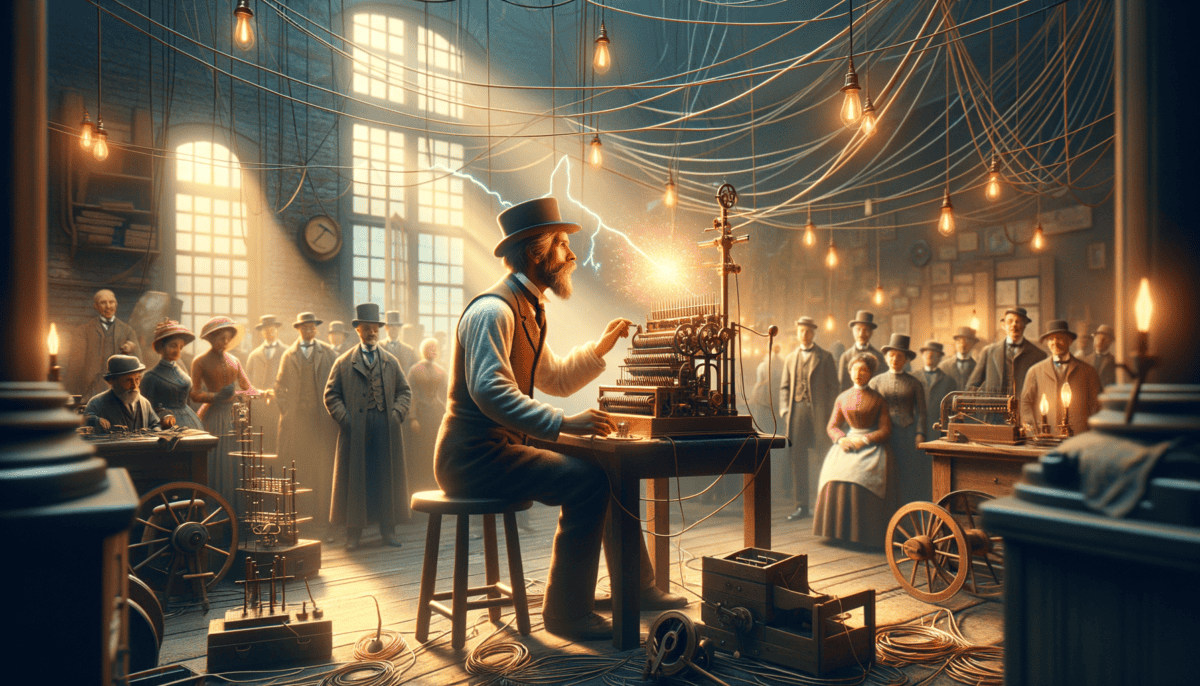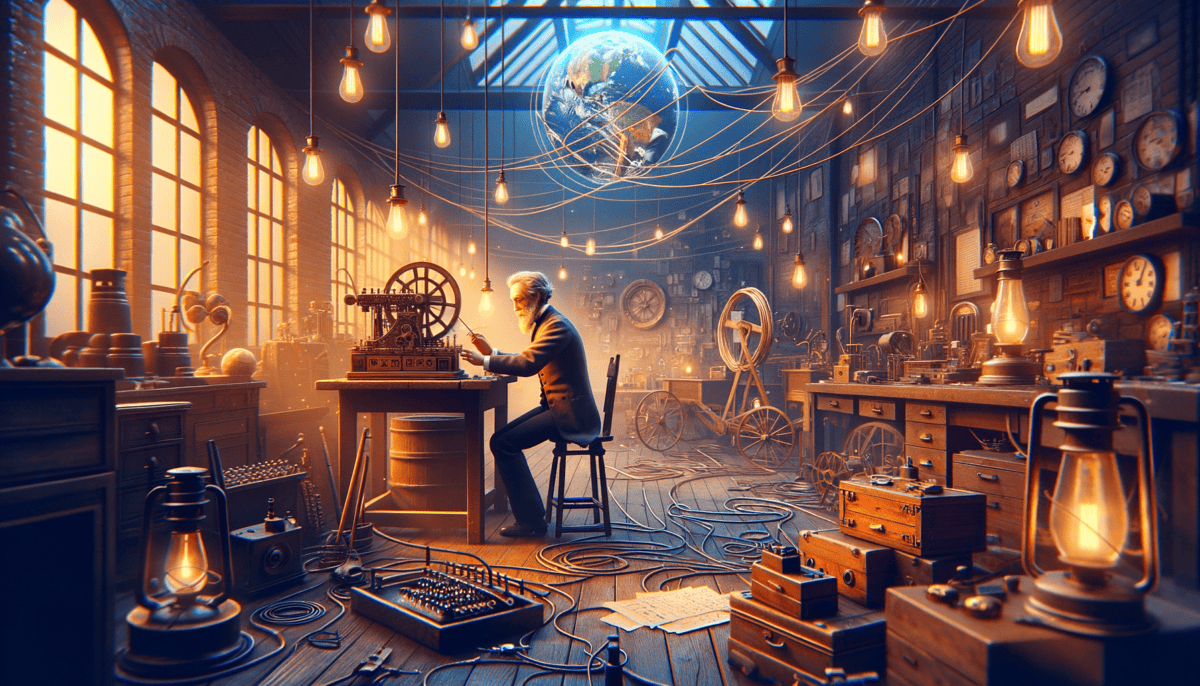The Artist’s Dream
Young Samuel Morse stood at his easel, paintbrush in hand, carefully adding colors to his latest portrait. The year was 1825, and the sunlight streamed through his studio windows in New Haven, Connecticut.
"Just one more stroke," he whispered to himself, dabbing blue paint onto the canvas. Samuel loved making pictures come alive. He was one of America's best portrait painters, and people came from far away to have him paint their faces.
But Samuel's heart wasn't fully happy. His wife Lucretia was far away in their home in New Haven, and he was in Washington D.C., painting important people. He missed her very much.
"Mr. Morse," a messenger boy burst into his studio, face red from running. "A letter for you, sir!"
Samuel's hands shook as he opened the envelope. His eyes moved quickly across the words, and suddenly, the paintbrush fell from his fingers.
Your wife Lucretia is very ill… Come quickly…
He packed his bags as fast as he could. But in 1825, traveling took a very long time. Horses and carriages were the fastest way to move, and they were still very slow.
By the time Samuel reached New Haven, it was too late. Lucretia had already passed away.
"If only there was a way to send messages quickly," he thought, sitting alone in his quiet house. "If only I could have known sooner…"
That night, as Samuel couldn't sleep, he remembered something interesting he had learned about electricity. Scientists had discovered that electric signals could travel very fast through wires.
Samuel sat up in bed, his mind racing with ideas. What if he could use electricity to send messages? What if he could make a machine that would help people talk to each other from far away?
The next morning, Samuel looked at his paints and brushes differently. He still loved art, but now he had a new dream. He wanted to build something that would help people send messages quickly, so no one else would have to go through what he did.
"I will find a way," he promised himself. "I will make a machine that can send words through wires as fast as lightning!"
He picked up his notebook and began to draw, but this time he wasn't drawing faces. He was sketching ideas for a new invention – something that would change the world forever.
Samuel didn't know it yet, but his sad experience would lead to one of the most important inventions ever made: the telegraph. His dream of sending fast messages would soon connect people all across America, and then the whole world!
That night, as he looked out his window at the stars, Samuel felt something new in his heart. It wasn't just sadness anymore. It was hope. Hope that he could turn his pain into something good. Something that would help everyone.
His artistic hands were about to create something very different from paintings. They were about to help build the first real way for people to talk to each other across long distances. The world would never be the same again.
Wires and Whispers
Samuel Morse sat at his workbench, surrounded by wires and strange-looking tools. It was 1832, and his art studio had transformed into a science workshop.
“How does electricity really work?” he wondered aloud, picking up a copper wire. The morning sun filtered through dusty windows, highlighting the scattered papers covered in drawings of electrical circuits.
A knock at the door interrupted his thoughts. “Come in!” he called.
Professor Leonard Gale, a chemistry teacher, stepped into the room. His eyes widened at the mess of equipment. “Mr. Morse, I heard you’re trying to send messages through wires?”
“Yes, but it’s not working yet,” Samuel sighed. “Watch this.”
He connected a battery to a wire and tried to make a needle move at the other end. The needle barely twitched.
“Ah,” Professor Gale smiled, “I think I can help. You need something called a relay to make the electrical signal stronger.”
Samuel’s eyes lit up. Together, they started experimenting with new ways to send electrical signals through wires. Some people laughed at them, saying it was impossible to send messages through metal strings.
“It won’t work!” one scientist told them. “Messages can only travel by horse and boat!”
But Samuel remembered his promise. He thought about his wife’s letter that arrived too late, and it made him work harder.
Here are the main things Samuel and Professor Gale discovered:
- Electricity can travel through long wires
- Relays can make electrical signals stronger
- Batteries can power the signals
- Magnets can help move needles to make marks
One day, while testing their latest design, something amazing happened. The needle at one end of the wire moved exactly when Samuel pressed a button at the other end!
“It works!” Samuel shouted, jumping up from his chair. “Professor Gale, it really works!”
Professor Gale clapped his hands. “This is just the beginning, Samuel. Now we need to figure out how to turn these signals into letters and words.”
Samuel grabbed his notebook and started drawing new ideas. His artist’s hands were now creating something bigger than any painting. He was building a bridge made of electricity that could carry words across great distances.
That night, Samuel wrote in his diary:
Today we made electricity dance through wires like magic. Soon, people everywhere will be able to talk to each other in the blink of an eye. I will not give up until this dream becomes real.
As he looked at his workbench full of wires and tools, Samuel smiled. He wasn’t just an artist anymore. He was becoming an inventor, and his new creation would change how people talked to each other forever.
The telegraph was starting to take shape, but Samuel still had a big challenge ahead. He needed to figure out how to turn electrical signals into letters and words that people could understand. His next big idea would solve that problem in a way that would be used for over 100 years!
Code of Connection
The warm candlelight flickered across Samuel Morse’s desk as he scratched his head. It was late at night in 1838, and he was trying to solve a big puzzle.
“How can I turn these electrical clicks into letters?” he wondered, tapping his pencil on the desk.
His friend Alfred Vail watched him curiously. “What if we use different types of clicks?” Alfred suggested.
Samuel’s eyes lit up. “Yes! Short clicks and long clicks!” He grabbed his paper and started writing.
They worked together all night, creating what would become known as Morse Code:
- Short click (dot) = .
- Long click (dash) = –
- Each letter had its own special pattern
- Simple letters got simple patterns
- The letter ‘E’ was just one dot because it’s used a lot
“Look!” Samuel exclaimed, demonstrating to Alfred. “If I tap dot-dash (.-)? That’s ‘A’! And dash-dot-dot-dot (-…) is ‘B’!”
Alfred clapped excitedly. “It’s like a secret language made of clicks!”
But not everyone believed in their invention. One day, a wealthy businessman visited their workshop.
“This clicking machine of yours,” the man scoffed, “why would anyone use it when we have perfectly good horses to carry messages?”
Samuel stood tall. “Because our telegraph can send a message from New York to Philadelphia faster than any horse could run!”
“One day,” Samuel promised, “people will send messages across entire countries in seconds, not days.”
Money was running low, and other inventors were working on their own telegraph systems. But Samuel and Alfred kept improving their code and machine.
They made a special dictionary that showed all the dot-dash patterns:
| A = .- | B = -… | C = -.-. |
One cold morning, a letter arrived that changed everything. A group of important people wanted to see their telegraph work!
“This is our chance!” Samuel told Alfred, his hands shaking with excitement. “If they like it, they might help us build telegraph lines across America!”
They practiced day and night, making sure their code worked perfectly. Samuel’s artist fingers, once used to hold paintbrushes, now tapped out messages with amazing speed.
During the demonstration, Samuel sent a message from one room to another:
The watchers gasped as Alfred read the message out loud in the other room. Their eyes grew wide with wonder.
“Incredible!” one man exclaimed. “You can really send words through wires!”
Samuel’s heart soared. His dream of fast communication was getting closer to becoming real. But the biggest test was still to come – they needed to prove their telegraph could work over long distances.
That night, Samuel wrote in his notebook with shaking hands:
Today we showed them that dots and dashes can speak louder than words. Tomorrow, we will make them travel further than anyone thought possible.
As the candle burned low, Samuel smiled at his code sheet. His simple dots and dashes would soon connect people across vast distances, bringing them closer together than ever before. ⚡
The Baltimore Line
The spring of 1843 brought exciting news – Congress had given Samuel Morse $30,000 to build his first big telegraph line!
“We’re going to connect Washington to Baltimore,” Samuel told his team, spreading out a large map. “It’s forty miles of wire we need to hang!”
Ezra Cornell, a clever farmer who joined the team, looked at the map. “The ground’s still frozen. We should wait for warmer weather.”
“We can’t wait!” Samuel said, pacing back and forth. “The money will run out!”
Their first try didn’t go well. They tried putting the wires underground in lead pipes, but it didn’t work. The wires got all mixed up!
“Sometimes the best path isn’t the one under our feet, but the one over our heads,” Ezra said wisely.
Samuel nodded. “You’re right! We’ll put the wires up high on poles instead!”
| First Try: | Underground wires ❌ |
| Better Plan: | Wires on poles ✅ |
The team worked super hard. Every day, they:
- Dug deep holes for poles
- Put up tall wooden posts
- Stretched wire between them
- Tested the connections
- Fixed any problems
But some people thought it was silly. “Look at those crazy men putting up strings in the sky!” they laughed.
One rainy day, a farmer stopped his wagon. “What are you doing with all these poles?”
“We’re building a way to send messages as fast as lightning!” Samuel explained excitedly.
The farmer shook his head. “Nonsense! Next you’ll say you can make pigs fly!”
May 1844: Almost there…
The work was hard. Sometimes storms knocked down their poles. Sometimes the wire broke. But they never gave up!
“Each pole we put up brings us closer to our dream,” Samuel would say, wiping sweat from his forehead.
Finally, after months of work, they were almost done. The line of poles stretched as far as they could see, like a giant connect-the-dots puzzle across the countryside.
Alfred Vail checked the last connection in Baltimore. “Everything’s ready here, Mr. Morse!”
Samuel stood in Washington, looking at his telegraph machine. His hands trembled with excitement. Years of work had led to this moment.
“Tomorrow,” he whispered, “we’ll send the first message between cities. Tomorrow, we’ll change the world.”
As the sun set, Samuel watched birds perch on his telegraph wires. Soon, those simple metal strings would carry words faster than any bird could fly. The next day would bring the biggest test of all – would their telegraph really work over such a long distance?
What Hath God Wrought
The morning of May 24, 1844 dawned bright and clear. Samuel Morse’s heart raced as he stood in the Supreme Court chamber in Washington, D.C.
“Today’s the big day,” Alfred Vail whispered, adjusting the telegraph machine. “Everyone’s watching!”
The room was packed with important people – congressmen, judges, and scientists. Some looked excited, others doubtful.
Annie Ellsworth, a young friend of Morse’s, stepped forward with a piece of paper. “I picked the perfect words from the Bible for your first message!”
“What hath God wrought?” Samuel read aloud, smiling. “Perfect indeed!”
His fingers trembled as he tapped out the message in his special dot-and-dash code:
The room fell silent. Everyone held their breath. Would the message reach Baltimore?
| Time: | 8:45 AM |
| Distance: | 40 miles |
| Speed: | Almost instant! |
Minutes passed. Then suddenly – click, click, click! The machine sprang to life!
“It’s Baltimore!” Samuel shouted. “They got our message and sent it back!”
The room erupted in cheers and applause. Even the doubters couldn’t deny it now – messages could travel faster than anyone had ever dreamed possible!
A congressman rushed forward. “Mr. Morse, this is amazing! Can I send a message next?”
Soon, there was a line of people waiting to try the telegraph. They sent all kinds of messages:
- News about Congress
- Friendly hellos
- Weather reports
- Business deals
- Happy birthday wishes
As Samuel watched, tears filled his eyes. “If only my dear wife could see this,” he thought. The tragedy that had sparked his invention now turned to triumph.
“This is just the beginning,” he told the crowd. “Soon we’ll connect every city in America!”
Newspapers across the country printed exciting headlines:
Professor Morse’s Telegraph Changes Everything!
That evening, Samuel sat alone with his telegraph machine. Click-click-click, it continued to bring messages from Baltimore. Each sound was like music to his ears.
“Remember this day,” he wrote in his diary. “The world will never be the same.”
And he was right! His telegraph would soon spread across America like a giant spider web, connecting people in ways they never imagined. Morse’s dream of instant messages had finally come true, and it was only the start of an amazing new chapter in history. ⚡
A World Connected
The sun rose over New York City in 1872. Samuel Morse, now an old man with white hair, sat by his window watching telegraph wires stretch across the city like silver threads in the morning light. ✨
“Can you believe it, Sarah?” he said to his daughter. “Those wires now reach all the way to California!”
“Tell me again, Father, how it all began,” Sarah smiled, knowing how much he loved sharing his story.
Samuel’s eyes twinkled as he remembered that first message years ago. Now, telegraph offices buzzed with activity in every major city.
People everywhere used the telegraph to:
- Send news across countries
- Help trains run safely
- Tell families about important events
- Run businesses better
- Warn about bad weather
A young messenger boy rushed into Samuel’s room. “Professor Morse! Look at today’s newspaper!”
Professor Morse’s Invention Changes How We Live
“Father,” Sarah said softly, “you did what seemed impossible. You helped people talk to each other across the whole world!”
Samuel smiled, remembering his long journey. From sad artist to famous inventor. From lonely nights of trying to make his dream work to seeing telegraph wires everywhere.
| Telegraph Lines in 1844: | 40 miles |
| Telegraph Lines in 1872: | Over 650,000 miles! |
“The best part,” Samuel said, “is knowing that no one else will get news too late about their loved ones, like I did about my dear first wife.”
That evening, Samuel heard telegraph sounds from a nearby office – click, click, click. Each sound reminded him of how far his invention had come.
“We are all connected now,” he whispered. “What a wonderful gift.”
Samuel Morse lived to see his telegraph change the world. His dot-and-dash code helped people share news, love, and friendship across great distances. And even today, when we send quick messages to friends far away, we can thank Samuel Morse for showing us how to connect with each other in amazing new ways. ⚡
His story teaches us that big dreams can come true, even when they seem impossible at first. All it takes is believing in yourself, working hard, and never giving up – just like Samuel Morse did.


